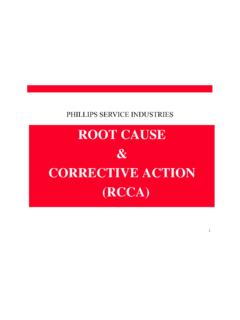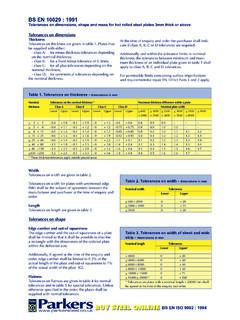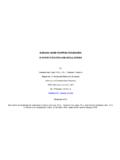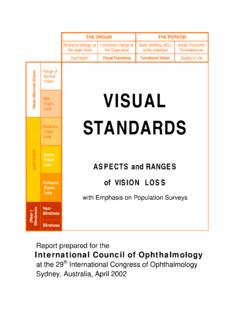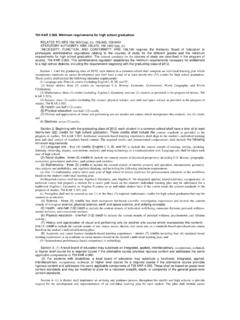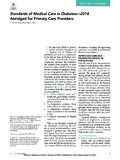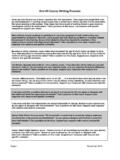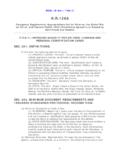Transcription of Workmanship Standards - web2 6-1-15 - Beaver …
1 Workmanship Standards . Dimensions and Tolerances Application and interpretation of dimensions and tolerances shall be in accordance with ASME Engineering Drawing Practices and ASME Dimensioning and Tolerancing Standard for procured items. Angles All angles, other than 90 angles, shall be specified on the drawing. Angles shown, as right angles shall be 90 within the general tolerance specified on the drawing except when squareness (perpendicularity) of a machined surface is a requirement. Flatness Machined Surfaces Machined surfaces shall be flat with the tolerances of the applicable linear dimensions of the drawing unless a specific flatness requirement is designated. Sheet Metal Surface Sheet metal surfaces shall-be free of wrinkles, sharply defined depressions or ridges, and shall be flat within the tolerances of the applicable dimensions of the drawing.
2 Surface irregularities such as bowing, oil-canning, spring back, and warpage, that can be brought within acceptable limits during fabrication and assembly by the application of thumb pressure are acceptable provided the discrepant part or assembly, when installed, is positively retained in the correct position or shape, and functions as designed without impairing the function of mating parts or assemblies. Lamination Surface Lamination surfaces shall be free of wrinkles, sharply defined depressions or ridges. If no flatness tolerances are given on the drawing, the following are to be applied. The lamination thickness shall be uniform from side-to-side within inches. See Figure Surface irregularities such as bowing, oil-canning, spring back and warpage that exceed the tolerances given in Figure are not allowed.
3 This applies to the finished lamination; after anneal, if it is an annealed lamination. The maximum burr height allowed, if not specified on the drawing, shall be less than inches. If this is evident at one or more locations on the lamination, it is indicating that the die is chipped or broken at those areas and the supplier is to be notified to repair the die prior to a subsequent order being filled. Burrs that extend into the slot or shaft hole areas are not allowed. An example of this type of burr is given in Figure Workmanship Standards . Concentricity Unless otherwise specified, the concentricity of adjacent machined elements shall be within inch total indicator reading (TIR) for items up to 3 inches in diameter, plus inch per inch of diameter above 3 inches. A maximum limit of inch TIR shall prevail for all machined elements on a single rigid item.
4 A maximum of inch TIR shall prevail for all machined elements on a single item having machined elements greater than inch diameter and subject to ready deflection as a result of a thin-wall condition. Gundrilled Holes Concentricity of gundrilled holes in shafts shall not exceed .005 to any adjacent diameter for the first two inches of drilled depth. The remainder of the gundrilled hole shall be concentric within an amount equal to .005 plus an additional .001 for each inch of depth beyond two inches to the point of measurement and not exceeding .015. total unless otherwise specified in the drawing. Roundness The roundness of all cylindrical or conical elements shall be such that the major and minor diameters of any section at any point must fall within the specified diametrical tolerances. The method of specifying a roundness tolerance for non-ridge parts shall be interpreted in accordance with ASME , Dimensioning and Tolerancing.
5 Standard. General Shop Practice Blended Surfaces Connected curved surfaces, or curved and plane surfaces shown as tangent, must blend smoothly without evidence of nicks, shoulders, re-entrant cuts, etc. The juncture of a radius with other radii or planes may have a 5 maximum angle of tangency for tool runout (see Figure ). Blends between adjacent planer surfaces Workmanship Standards . of essentially flat and parallel nature shall be smooth and flat or slightly convex;. concave blends establishing re-entry intersections are not permissible. Internal Corners All internal corners of machined parts shall have a radius between and inch, unless otherwise specified. Breaking Sharp Edges Unless otherwise specified on the detail drawing, all sharp edges shall be broken. The breaking of the edge may be in the form of a radius or a combination of a chamfer and radii.
6 Edges after breaking must be free of burrs. Remove all visible burrs. No projections visible to the unaided eye are permitted beyond the normal plane of adjacent surfaces. Small projections that are too small to be detected by normal unaided vision may remain. Any remaining material shall not cause dimensions to fall out of drawing specifications. This specification level also requires that edges shall not be sharp to the extent that they could cut hands. A flat chamfer evidencing corner sharpness from burrs, or a concave radius within the chamfer flat, is not acceptable. The breaking of edges on sheet metal parts 1/32 inch or less in thickness is not mandatory such edges must be free from burrs. This breaking of edges does not apply to parts fabricated from elastomers or non-rigid polymers. Note: Dimensions to intersecting surfaces are theoretically to sharp corners and must be met before breaking edge or including fillets unless specifically delineated on the drawing.
7 Chamfer Chamfers, when specified on a drawing, may be at the intersection of two surfaces of any geometrical shape, the exterior edge of a cylindrical surface, the internal edge of a hole irrespective of hole shape, or a circular hole too large for countersinking tools. Note: Holes inches in diameter or larger are considered too large for countersinking. Workmanship Standards . Chamfer on Internal Thread Ends A chamfer with an included angle of 80 to 120 shall be used at internal thread ends unless otherwise specified by dimensional notation or specification reference on the drawing. The minimum diameter of the chamfer shall be equal to the major diameter of the thread. The maximum diameter of the chamfer shall be equal to the major diameter of the thread plus inch. Chamfer on External Thread Ends Unless otherwise specified by dimensional notation or specification reference on the drawing, externally threaded parts shall be chamfered at the ends, extending to the minor diameter of the thread.
8 The angle of the chamfer shall be 45 +5 / -15 . The minimum length of the chamfer shall equal the depth of the external thread, from the major to the minor diameter. Theoretical Single Surface When two or more machining cuts are required to produce a surface shown on the drawing as a single surface, the maximum misalignment between intersecting or adjacent surfaces shall not exceed inch or must be contained within the limits of dimensional size, whichever is the smaller. When a continuous surface is required, this requirement shall be designated on the detailed drawing. Drilled Holes Depth The depth of a drilled hole, as specified on the drawing, shall be measured along with the axis of the hole from the surface drilled (reference surface) to the depth of the full diameter exclusive of the drill point.
9 Angularity The angularity of all drilled holes must be within the tolerance zone established by the center line position, over the full depth of the hole. The tolerance zone may be extended beyond the hole depth (above the reference plane) by special notation on the drawing. Roundness The deviation from roundness of the drilled hole shall not exceed the tolerances of the hole diameter. Countersink, Counterbore and Spot Face Countersink Term used to designate a conical surface at the edge of a circular hole. It does not apply to holes of inch diameter or larger. Countersink major diameter and included angle must be specified on the drawing. Counterbore Workmanship Standards . A requirement for counterboring must be designated on the drawing. When required, the diameter and depth, or the diameter and material thickness below the counterbore must be specified on the drawing.
10 Counterbore corner radii shall be inch maximum. Spot Face When spot facing is required, the spot face diameter shall be specified on the drawing. The following depth limits shall apply: a. Minimum depth shall be the depth necessary to provide 75% clean-up of spot face area. b. Maximum depth shall be inch beyond 100% clean-up. c. Spot Face corner radii shall be inch maximum. Machining Centers Center drilling may be desirable in shafts, spindles and other cylindrical or symmetrical parts to receive machine centers for work support. Unless otherwise specified on the drawing, their use is optional within the parameters stated below. Pinions The major diameter of the conical portion of the drilled center shall not exceed 60% of the pinion root diameter. Solid Shafts A No. 0 or 00 center drill shall be used for shaft diameters approximating 1/8 inch.
